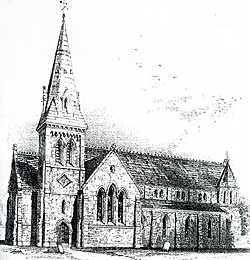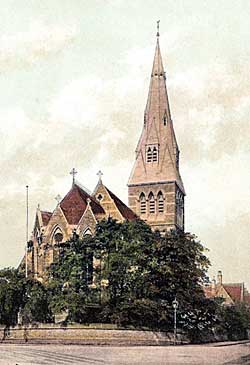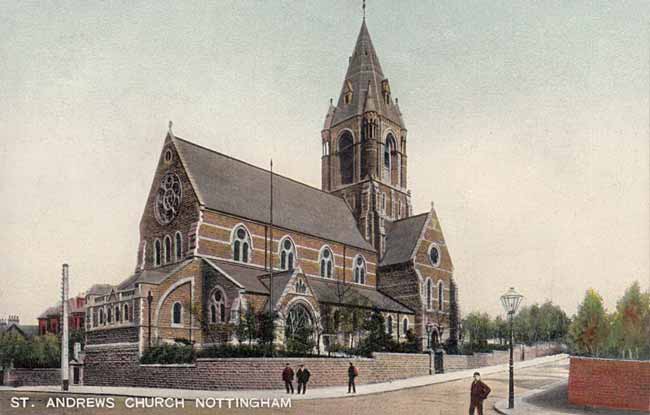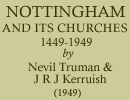St. Ann's, lying in a thickly-populated artisan area on either side of St. Ann's Well Road, was consecrated in 1864. The design is Early Decorated. The windows are filled with geometrical tracery, and no two windows are alike in design. It has an elaborate pulpit and font. The north transept was added in 1879, and the north aisle in 1882. Two years later the chancel was enlarged and in 1896 the east window, depicting the Ascension, was presented by the congregation in commemoration of the twenty-five years' ministry of Canon J. D. Lewis. In 1937 new choir and clergy vestries were added as memorial gifts. The Rev. C. C. B. Bardsley (afterward Bishop of Peterborough and first Bishop of Leicester) was Vicar from 1901 to 1904 and the Rev. J. Walmsley (afterwards Bishop of Sierra Leone) from 1904-1910. In 1939 an oak Holy Table was dedicated in memory of Bishop Walmsley.

St Mathew's church, Talbot Street.
St. Matthew's was in its heyday during the long reign of Canon Ferris, a stout-hearted Yorkshireman of robust constitution and churchmanship. With his long white beard, his ruddy complexion and his harsh croaking voice, he had the appearance of an Old Testament prophet, and his fonder admirers were wont to see a likeness of him in the window of St. Matthew in the church. He was greatly loved, for, despite his stern aspect, he had a tender spirit and an affectionate nature. It was his boast that he had the ugliest east window in Nottingham, but unfortunately it now has serious rivals for that doubtful honour.
The north transept window contains in its outer lights large single figures of saints set in clear glass, given years later by the same family who presented the centre light of heavy and poor design. The modern treatment of the outer lights is so good that one wishes it could be applied to the rest of the window. There are one or two other good modern windows.
The church, vicarage and parish institute form a closely packed unit in Talbot Street.

All Saint's church.
All Saints' was founded by the munificence of a rich silk merchant, William Windley, whose action inspired other churchmen, and some half dozen other churches were built at the same time. He planned on almost collegiate scale, grouping round a central lawn the church, the vicarage, large parish halls, and verger's house. Schools were also provided nearby. All was on spacious Victorian lines, the vicarage being the largest in Nottingham. Two members of the family have occupied it—the Rev. T. W. Windley and the Rev. H. M. Lonsdale—and the family are still the patrons of the living. The church contains some good glass, notably that in the Lady Chapel by Miss Townsend and Miss Howson of London, which is unusual, very symbolic and kaleidoscopic in its treatment. The late Harry Gill, an architect, was a worshipper at All Saints' and he designed the tall spire font cover, traditional in shape yet modern in detail; also the war memorial at the end of the south aisle. The apsidal chancel is covered with good oak panelling, carved by Bridgman of Lichfield, with a reredos to match, into which has lately been inserted, as a triptych, a painting of the Feeding of the Five Thousand, by a Nottingham artist, Hammersley Ball; and it is good to record the employment of an artist instead of the more prevalent choice of a commercial firm.
The Church Schools provided by the founder, on Forest Road West, had a long period of usefulness but were, alas, relinquished to the secular educational authority some years ago. They now bear the name of the Windley School in place of their former title of All Saints' School.
St. Matthias', Sneinton, is one of several churches built in Nottingham during the 1850's and '60's to provide for the vast new artisan areas which were the accompaniment of Victorian industrialisation. It was formed out of the original parish of St. Stephen's, Sneinton, and consecrated in 1867.

St Andrews church.
St. Andrew's is a great Evangelical Church which has wielded a powerful influence upon the life of Nottingham since it was built in 1871. Its great advantage is its position, crowning the top of the former Gallows Hill, with its tower visible from the other side of the Trent on the south to Bulwell on the north. From a distance the tower gives an impression of grandeur and loftiness which is not so apparent from close up. The style of the building is an unusual kind of French Gothic. Its interior has been greatly enhanced in recent years. A magnificent oak chancel screen, with fan vaulting, was provided in memory of an only son lost in the first war. The delicate panelling of the sanctuary and the alabaster reredos were given in 1918 by John and Margaret Player "For 25 years of Happy Married Life". The reredos shows Christ enthroned, a lovely Nativity scene in which an ass and an ox peep over the stable wall and gaze upon the Infant Saviour, Christ walking with two disciples, the Baptism, Gethsemane, and the Resurrection with an angel and two sleeping soldiers. In this present year, the interior of the church has been entirely cleaned and recoloured in lighter hues, and it now possesses a genuine beauty such as it had never known before. Among its previous vicars was the Rev. Frank Woods, father of the late Bishop of Winchester and the present Bishop of Lichfield. The church has a fine organ, beautifully encased, and maintains a high musical standard, as is evidenced by the regular broadcasting of its choir. An outstanding feature of the church's work has been its zeal for the Missionary cause. Not only does it subscribe hundreds of pounds each year to Missionary societies, but it has provided over a long period a steady flow of recruits for the Mission field.
St. Jude's began life in the office of the Mapperley Brick Co. until a church was built. Mapperley, then a village, had no church nearer than St. Mary's and the steep hill on the homeward journey provided heavy walking for the faithful. Services were moved from the company's office to the new Church Day School in 1860 and seventeen years later into the nave of St. Jude's, which was consecrated by Henry Mackenzie, first suffragan Bishop of Nottingham.
The east end was added in 1892, followed during the next few years by an organ chamber, north and south aisles, and later a memorial chapel to commemorate those who died in the first world war. Vestries were built in 1925, and on November 9th, 1926, by the usual Order in Council, His Majesty sanctioned the creation of a separate parish. The first vicar, the Rev. E. A. Dunn (now Prebendary of St. Paul's), made a deep impression through his preaching and pastoral gifts and thus from the start the church was built on strong foundations. The congregations increased and hence the last bay of the church was added, connecting nave with vestries and finally completing the whole scheme.
The area contains a good deal of the prosperous Mapperley Park residential district on the east side, with a distinct contrast to the west in the smaller houses running down the steep Mapperley heights to the lower Sneinton levels, and very thickly populated.
The church, which is of brick with stone dressings, is more or less Early English and Decorated, and though it has no particular architectural pretensions it has a fresh, light, attractive interior.
St. Augustine's, New Basford. The ecclesiastical parish of New Basford was formed by an Order in Council in 1847. The first incumbent began his work in two rooms in Olives Square, one used as a church and the other as a school, and for which respectively a rent of 1s. 6d. and 2s. 6d. a week was paid. After fifteen years' work under these conditions a real church and school were built: the church now forms the south chapel and clergy vestry of the present church, and the school the infants' department of the present school. The nave of the present church was added in 1877. In 1884 the north aisle was consecrated and the chancel was added in 1895. In 1910 the east window was inserted and in 1911 the fine oak screen and pulpit.
St. Philip's is the memorial of Thomas Adams, that lace manufacturer who provided a chapel in his warehouse with a daily service for his workpeople—a most striking form of practical Christianity. "The chapel regulates the business: don't let the business extinguish the chapel. Let us give up everything which we cannot ask God to bless" was his instruction. He was a generous supporter of churches, schools and foreign missions, a magistrate and a member of the Board of Guardians much loved for his character and his philanthropy. Ten thousand people attended his funeral and he has permanent memorials in the name "Adams' Hill", the vast transept window of St. Mary's, and another at Lenton, besides St. Philip's church.
When St. Philip's was built there were 5,000 parishioners, but slum clearance and the increase of business premises has reduced the residential numbers and it was considered well to add the parish of St. Luke, demolishing that church. Its old schools are now a parish room and furniture from St. Luke's provides a side chapel in St. Philip's.
During the last fifteen years many improvements have been made, including a reredos, stained glass windows round the apse and in the nave, an inner porch, and a litany desk, while a new parish room now adjoins the church.
There is an atmosphere of comfortable seemliness about this church, and, architecturally, it is a satisfactory church of its kind.
Emmanuel was built by one of Nottingham's really distinguished architects, though his work was almost all in the domestic sphere. He must have been influenced by the work of William Butterfield, for he adopts the Butterfield peculiarity of multi-coloured bricks and tiles with which to cover the interior, though happily he has not gone to the lengths that Butterfield went in All Saints, Margaret Street. We have passed out of this architectural phase now, but the church has a certain attraction and can be classed as one of the better models of its time. The baptistry contains a painting of the Incredulity of St. Thomas. One vicar has risen to great eminence. He is Llewellyn Gwynne, who became Bishop of Khartoum and later Bishop in Egypt and the Sudan, and raised the great cathedral at Khartoum.
He had been curate of St. Andrew's before going to Emmanuel. He has received many honours including the C.M.G., the D.D. and the Ll.D., and he is happily still with us at an advanced age and with undiminished vigour.
